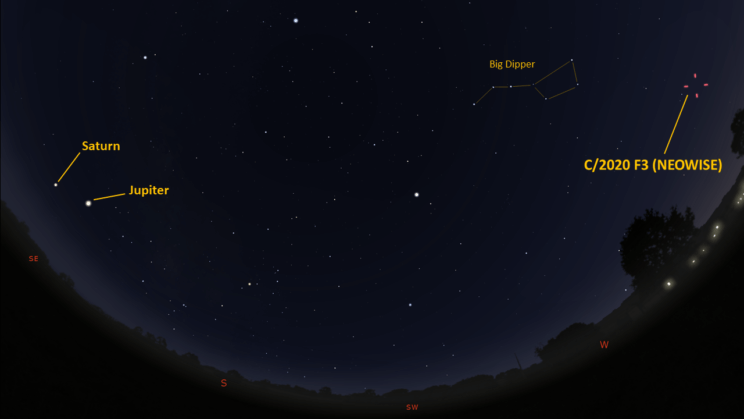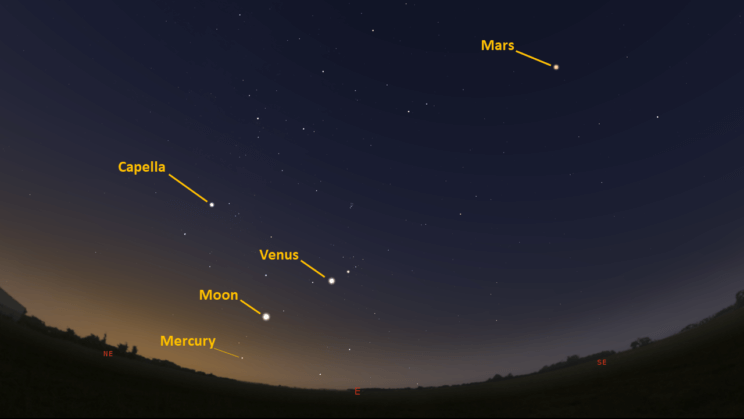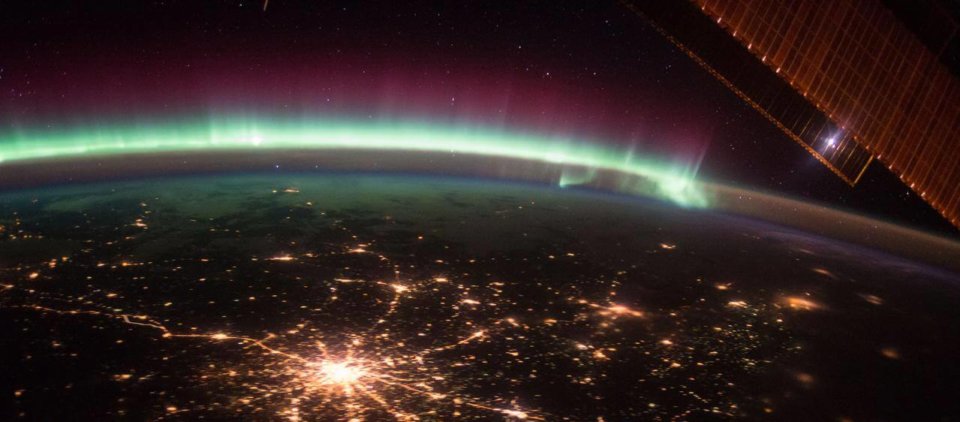This is the Saint Louis Science Center’s NIGHT SKY UPDATE for the week of Friday, July 17, 2020.
Information updated weekly or as needed.
Times given as local St. Louis time (CDT). For definitions of terminology used in the night sky update, click the highlighted text.
Star parties at the Saint Louis Science Center have been canceled due to recommendations from the CDC regarding COVID-19. All public telescope events are canceled until further notice. As conditions change, we will reevaluate and update this article once public observing events resume.
The Sun and Moon

The Moon as seen from the International Space Station, on July 31, 2011.
Credit: NASA
Sunrise is at 5:51 a.m. on Friday, July 17 and sunset is at 8:18 p.m. providing us with about 14.5 hours of daylight. Even after sunset, the light from the Sun will dimly illuminate our sky for roughly 2 hours. This period is called twilight, which ends around 10:15 p.m. this week. For those with a sundial, local noon occurs around 1:07 p.m. this week.
| Day | Sunrise | Sunset |
|---|---|---|
| 2020-07-17 | 5:51 a.m. | 8:23 p.m. |
| 2020-07-18 | 5:52 a.m. | 8:23 p.m. |
| 2020-07-19 | 5:52 a.m. | 8:22 p.m. |
| 2020-07-20 | 5:53 a.m. | 8:21 p.m. |
| 2020-07-21 | 5:54 a.m. | 8:21 p.m. |
| 2020-07-22 | 5:55 a.m. | 8:20 p.m. |
| 2020-07-23 | 5:56 a.m. | 8:19 p.m. |
| 2020-07-24 | 5:56 a.m. | 8:18 p.m. |
| 2020-07-25 | 5:57 a.m. | 8:18 p.m. |
Moonrise for Friday, July 17 occurs on the previous day at 2:58 p.m. and moonset will occur at 5:57 p.m. On Friday, July 17 the Moon will exhibit a waning crescent phase with about 9% of the lunar disk illuminated. New moon occurs on July 20 at 12:33 p.m.
International Space Station (ISS) Observing

Visible passes of ISS from St. Louis for the week of July 10 occur during morning and evening hours. The best of these occurs on the evening of July 18. Use the table below for information about this and other visible passes of ISS.
Catch ISS from St. Louis starting Friday, July 17
| Time | Alt. | Az. | Time | Alt. | Az. | Time | Alt. | Az. | ||
|---|---|---|---|---|---|---|---|---|---|---|
| 17 July | -2.9 | 03:30:09 | 10 | NW | 03:33:25 | 50 | NE | 03:36:42 | 10 | ESE |
| 17 July | -2.1 | 05:07:47 | 10 | W | 05:09:54 | 16 | SW | 05:12:02 | 10 | S |
| 17 July | -1.5 | 21:49:06 | 10 | W | 21:52:02 | 27 | NNW | 21:54:59 | 10 | NNE |
| 18 July | -0.9 | 02:42:19 | 10 | NW | 02:42:59 | 14 | NNW | 02:42:59 | 14 | NNW |
| 18 July | -2.3 | 21:00:44 | 10 | WSW | 21:03:56 | 42 | NW | 21:07:10 | 10 | NE |
| 19 July | -0.6 | 21:51:07 | 10 | WNW | 21:53:10 | 15 | NNW | 21:55:13 | 10 | NNE |
| 20 July | -0.4 | 01:06:51 | 10 | NNW | 01:07:33 | 13 | N | 01:07:33 | 13 | N |
| 20 July | -0.9 | 21:02:23 | 10 | WNW | 21:04:57 | 20 | NNW | 21:07:31 | 10 | NNE |
| 21 July | -0.5 | 00:19:12 | 10 | NNW | 00:20:39 | 13 | NNE | 00:20:39 | 13 | NNE |
| 23 July | -0.5 | 00:19:17 | 10 | NNW | 00:20:03 | 14 | NNW | 00:20:03 | 14 | NNW |
| 23 July | -0.9 | 23:31:32 | 10 | NNW | 23:33:24 | 16 | NNE | 23:33:24 | 16 | NNE |
Magnitude (Mag): The Measure of brightness for a celestial object. The lower the value is, the brighter the object will be.
Altitude (Alt): The angle of a celestial object measured upwards from the observer’s horizon.
Azimuth (Az): The direction of a celestial object, measured clockwise from an observer’s location with north being 0°, east being 90°, south being 180° and west being 270°.
For information about ISS flyovers and other visible satellites, visit www.heavens-above.com
Detailed information regarding all unmanned exploration of our universe, missions past, present, and planned, can be found at Jet Propulsion Laboratories:
The Visible Planets

Sky from St. Louis, at 9:00 pm, July 17, 2020
Credit: Stellarium, EG

Looking East, 5:00 am, July 18, 2020
Credit: Stellarium, EG
This week, all five naked eye planets are visible. Mercury will join Venus in the eastern sky before sunrise by July 18. Jupiter and Saturn rise in the evening but are better seen after midnight. Look for them rising in the southeast and after midnight they will be in the south. Mars will be best seen in the southeast a few hours before sunrise. Venus and eventually Mercury will be in the eastern sky just before sunrise.
For those tracking Jupiter and Saturn as they approach their great conjunction later this year, the two gas giants currently appear about 6.9° apart in the sky. Jupiter appears to be moving away from Saturn right now due to retrograde motion. This is all an illusion caused by Earth passing by slower moving Jupiter. Saturn has also started retrograde motion. If you keep watching these planets as 2020 progresses, you will see some interesting behaviors that inspired early astronomers to track the skies.
Mercury
Mercury starts another morning apparition this week becoming visible in the east about 40 minutes before sunrise on July 18. Mercury will continue to elongate from the Sun until July 22 when it reaches maximum western elongation. After this date Mercury will head back towards the Sun as it approaches superior conjunction on August 17. The best chance to see Mercury will be between July 18 and July 31.
Venus
Venus has begun another morning apparition. After months of seeing Venus in the west after sunset Venus is now visible in the east before sunrise. Venus rises at 3:07 a.m. and will be easily seen by 4:00 a.m. Venus remains a morning object until March 26, 2021 when it reaches superior conjunction. Venus reaches maximum western elongation on August 12, 2020.
Mars
The red planet rises around 11:58 p.m. and will be high enough to see in the southeast by 1:00 a.m. Opposition for Mars occurs on October 13, 2020. As we head towards this date Mars will appear brighter and larger through a telescope improving surface details. Surface features are already visible when viewing conditions are favorable.
Jupiter
Jupiter has passed opposition and as such will rise before the Sun sets each day. Look for Jupiter in the southeast about 30 minutes after sunset. Those with a telescope can enjoy views of Jupiter’s cloud features and the Great Red Spot when it is pointed towards Earth.
Saturn
Saturn is rising around 8:29 p.m. and will be visible in the southeast around 9:30 p.m. Saturn reaches opposition on July 20. For those with a telescope keep track of the orientation of Saturn’s rings. Since Saturn is tilted on its rotational axis, we cross the plane of Saturn’s ring every 13 to 15 years. We are headed towards another ring plane crossing on March 23, 2025. Over the next five years you will notice Saturn’s rings will gradually incline towards an edge on appearance.
2020 Great Conjunction
This year the planets Jupiter and Saturn will reach conjunction. A conjunction is when two or more celestial bodies share the same right ascension. For Jupiter and Saturn this astronomical event occurs every 20 years. The conjunction occurs on December 21, 2020. You will find the two planets close together in the southwest just after sunset on this date.
Comet C/2020 F3 (NEOWISE)
After two disappointing comets, we finally have a bright comet to observe in St. Louis. On March 27, 2020, a comet now named C/2020 F3 (NEOWISE) was discovered in survey data from NASA’s NEOWISE space telescope. NEOWSIE was the extended mission of NASA’s WISE infrared space telescope. As NEOWISE the telescope focused on surveying the sky for Near Earth Objects (NEOs) which are asteroids and comets that come near or could cross Earth’s orbit.
C/2020 F3 (NEOWISE) reached perihelion on July 3, passing about 43 million km from the Sun. After perihelion, this comet started to climb out of the twilight glare of the Sun becoming visible just before sunrise. It has now moved into a part of the sky that favors evening views shortly after sunset.
C/2020 F3 (NEOWISE) has reached its peak brightness and will continue to fade as it moves away from the Sun. Dark locations are reporting it is visible naked eye but in light polluted conditions you will need binoculars to spot this comet. Its current brightness is just over 2nd magnitude which will continue to fade as we head through July. By August 2020, the comet is predicted to fall to 5th magnitude making it difficult to spot in light pollution.
As of this week I have observed the comet in light polluted and hazy conditions through a variety of binoculars ranging from 6×30 to10x50. The coma now appears larger than the previous week and less point-like. The comet displays a bright cone-like dust tail that was easily seen in binoculars. This is the best comet we have seen in St. Louis for several years and it is worth getting out to see it at its best. The best opportunity to see C/2020 F3 (NEOWISE) is after 9:00 p.m. looking northwest about 15° to 18° above the horizon. The location of (C/2020 F3 NEOWISE) will change daily so it will be important to find a good map of the comet’s location. The best visual guide for finding the comet is the Big Dipper. C/2020 F3 (NEOWISE) will continue to move through the constellation Ursa Major for most of July until it reaches Coma Berenices on July 29.
More information and detailed maps can be found here
https://cometchasing.skyhound.com/
Visit the James S. McDonnell Planetarium for more information on what’s up!
Night Sky Update: July 17-July 25, 2020






